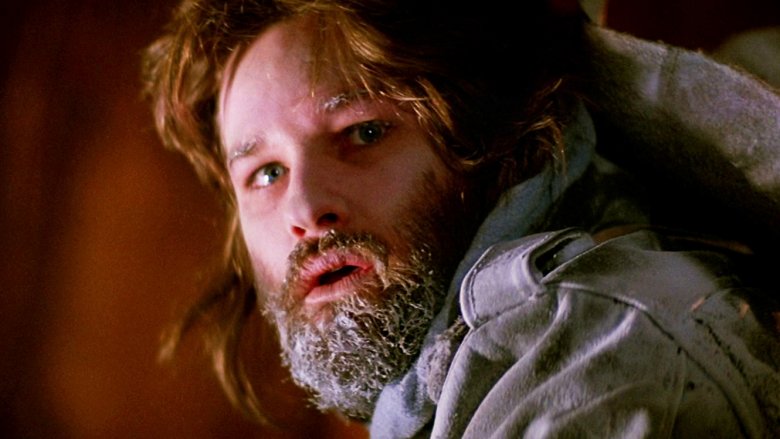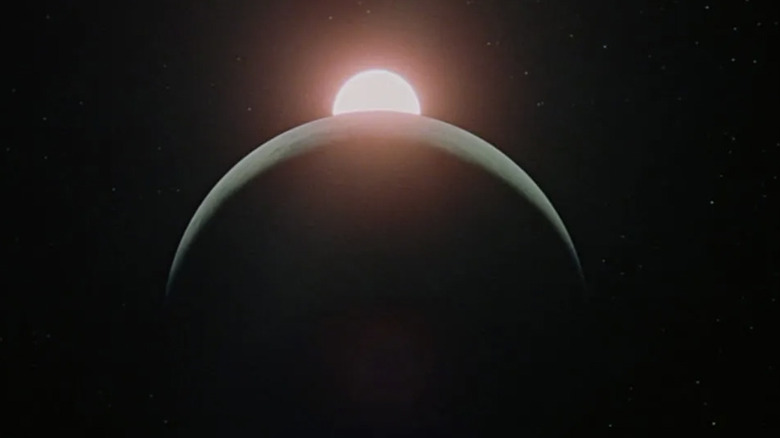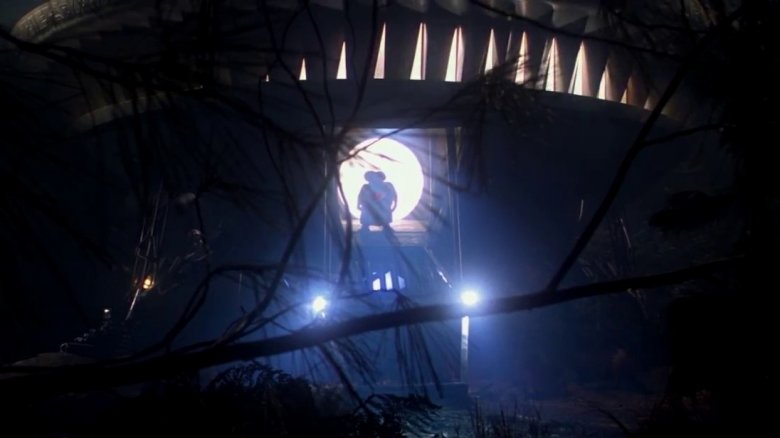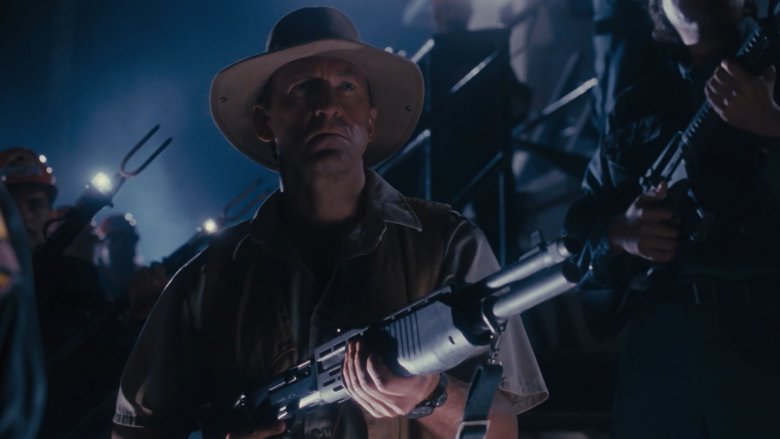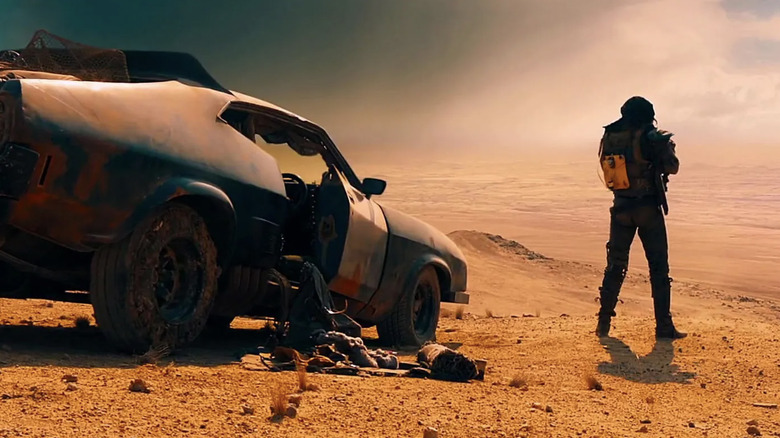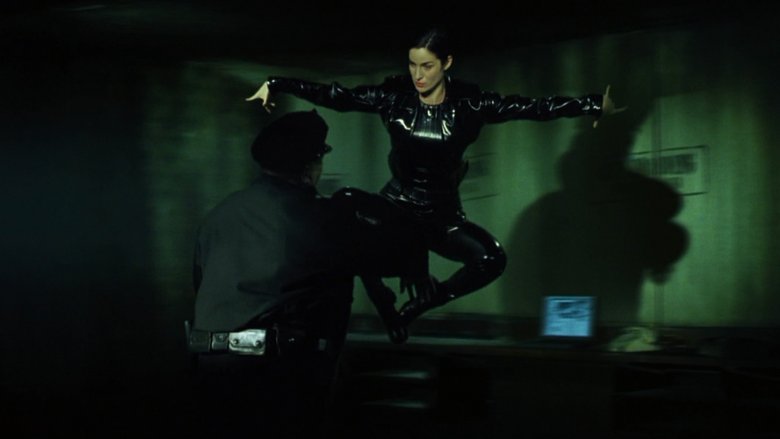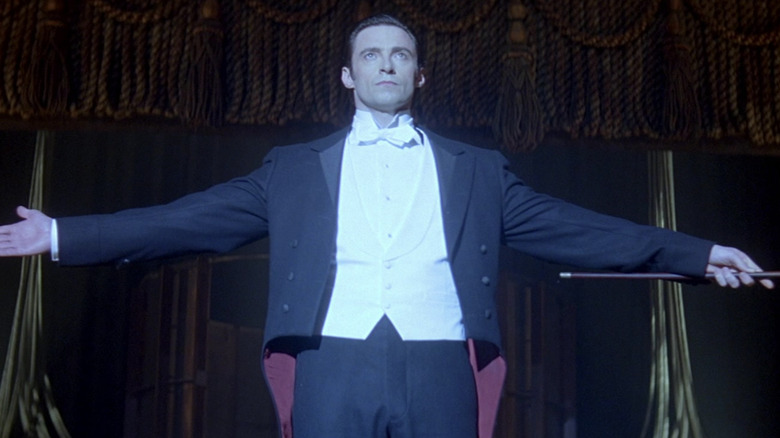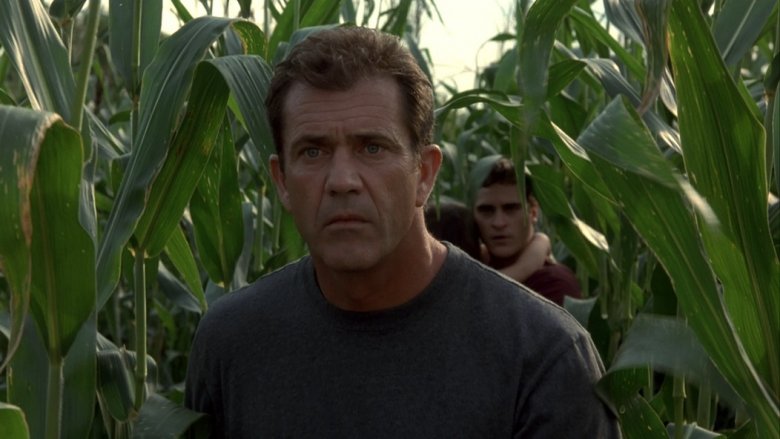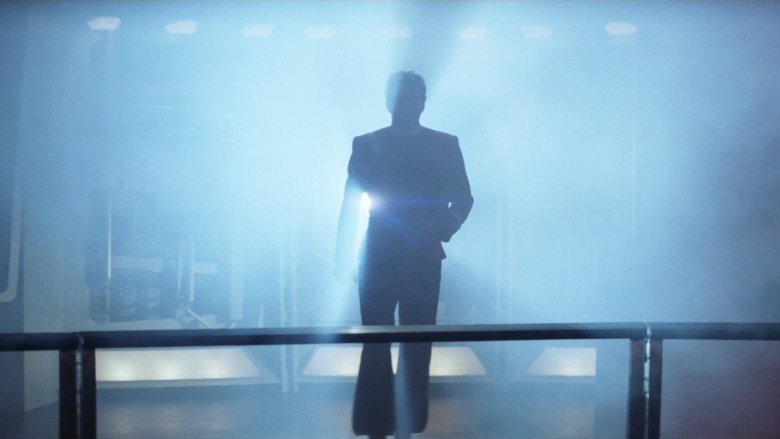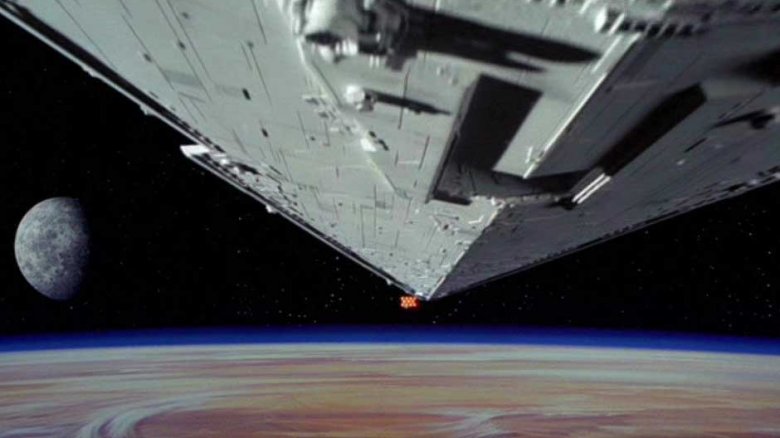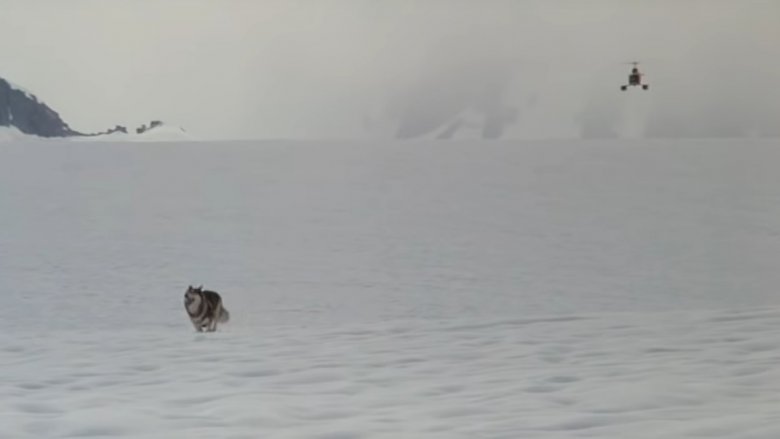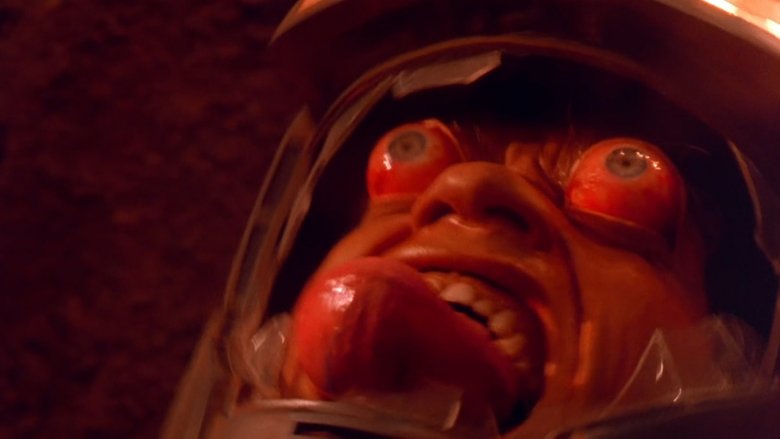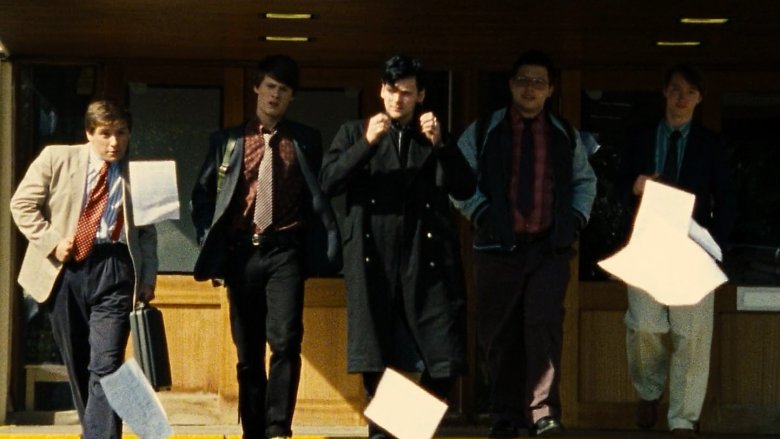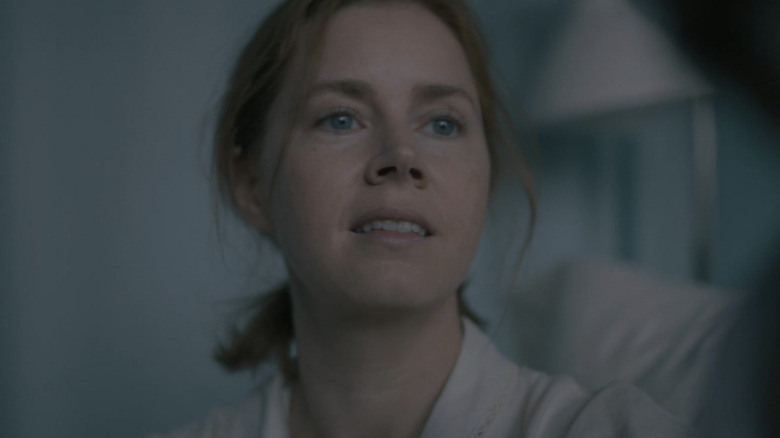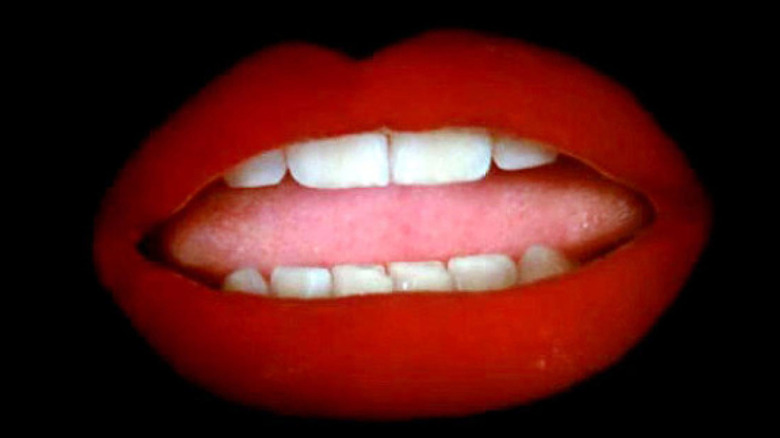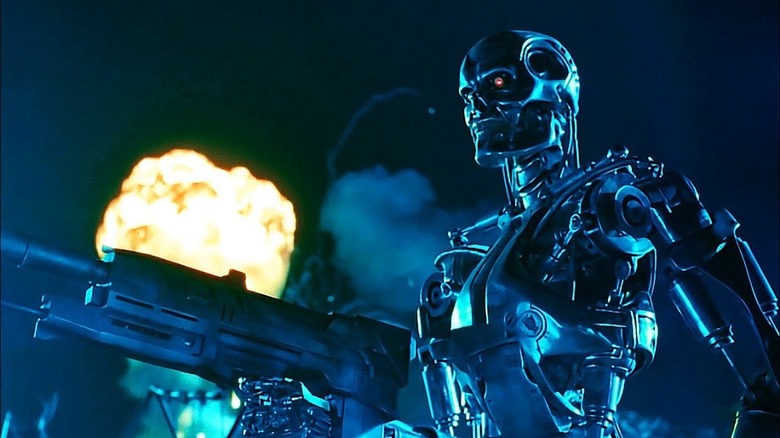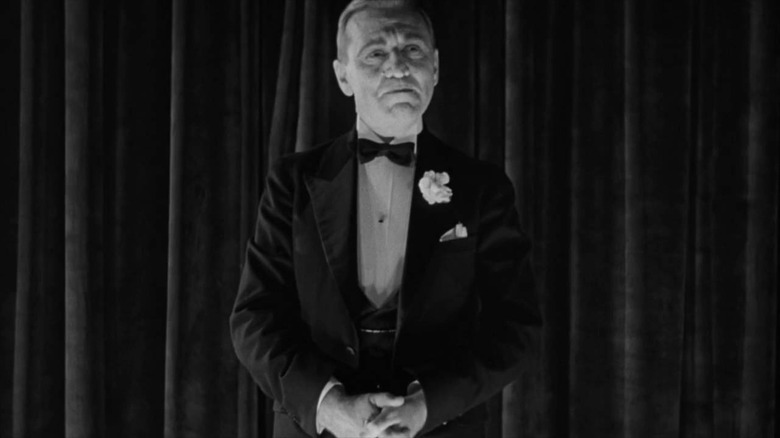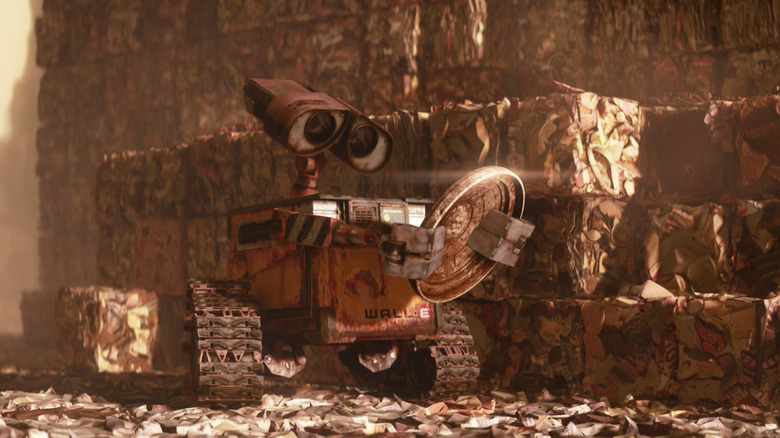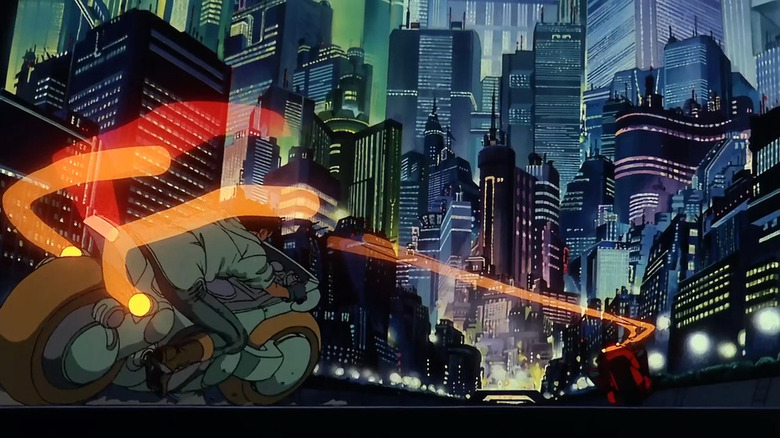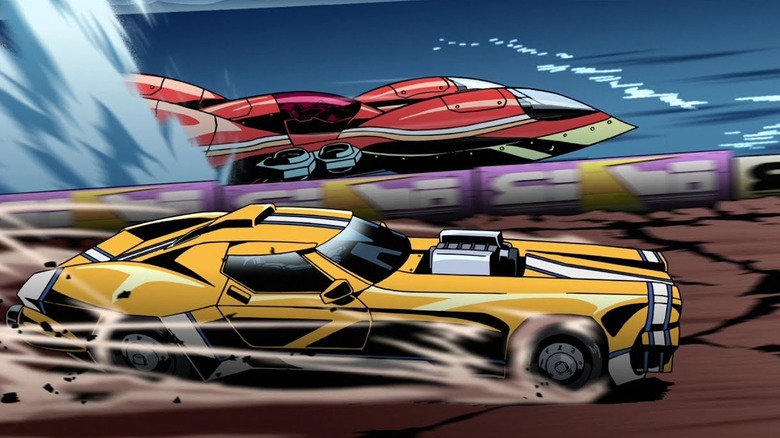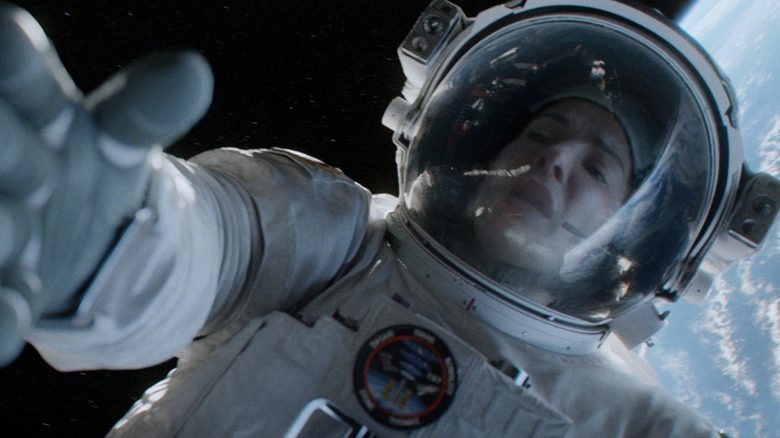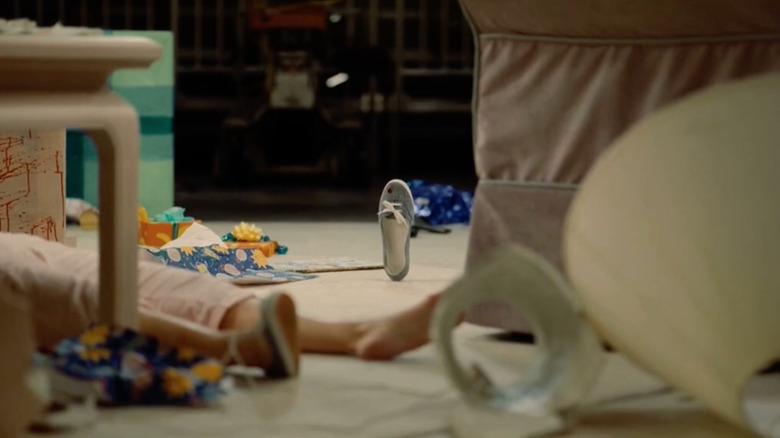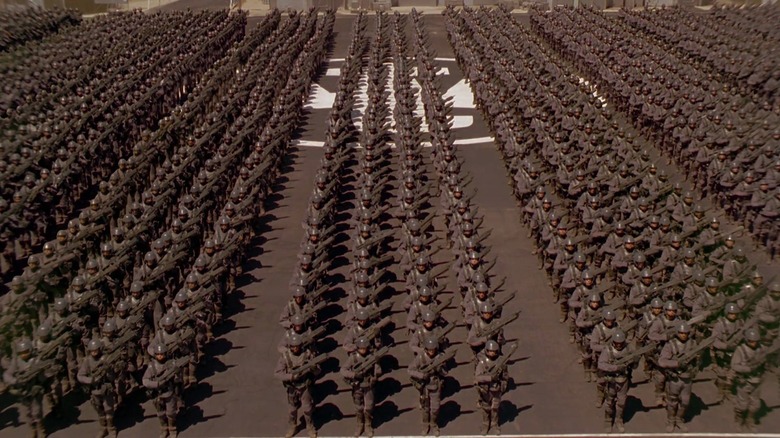The Best Opening Scenes In Sci-Fi Movies
Science fiction films tell some of the most exciting stories that cinema has to offer. The genre expands our minds and takes us to places we've never even imagined. Sci-fi can send us back in time, put us on the moon, or introduce us to all sorts of creatures like robots, aliens, and dinosaurs. But while a sci-fi movie needs to push boundaries and have a compelling story, it also needs a killer opening scene.
What good is your tale of stranded astronauts or evil A.I. if the first few minutes of the movie are totally boring? To draw us in, a film needs to set the stakes right off the bat. It needs to prod our imagination, play with our curiosity, and make us wonder what will happen next. Whether they make us laugh, cry, or stare in awe, these are the best opening scenes in sci-fi movies.
Warning: some spoilers below.
2001: A Space Odyssey - The celestial bodies align
Stanley Kubrick's "2001: A Space Odyssey" is full of moments that have permeated pop culture. There's the mysterious Star Child, the legendary match cut, and the murderous HAL refusing to open the pod bay doors. And right up there with all those iconic scenes is the opening sequence where the celestial bodies align.
The shot opens on the dark side of the moon, and the camera slowly pans up, revealing the Earth shrouded in the darkness of space. But then the sun begins to rise on the far side of the world, illuminating the entire shot. The grandeur of the universe is on display, but what really sells the moment is the booming, bombastic music. Kubrick famously chose to score the film with classical compositions, and here he uses "Thus Spake Zarathustra" by Richard Strauss. And without that song to punctuate the scene, the opening just wouldn't have worked.
Believe it or not, Kubrick originally intended to use a completely original score for the film, one written by Alex North (via Slate). North had composed music for films like "Spartacus" and "A Streetcar Named Desire," but his score for "2001" just wasn't working, so Kubrick decided to get classical. And by using a piece written in 1896 for a film released in 1968, Kubrick created an opening that's become absolutely timeless.
E.T. the Extra-Terrestrial - Getting left behind
Steven Spielberg knows how to start a movie. From "Jaws" to "Raiders of the Lost Ark," his openings grab you by the collar and never let go. The first few minutes of "E.T. the Extra-Terrestrial" are no exception. This 1982 classic begins with a spaceship parked in a foggy California forest. Its adorable crew is waddling through the woods, collecting plants. They're intergalactic botanists having the time of their lives among the redwoods. That's especially true for E.T., who's wandered away from his buddies to find the perfect sapling.
The peaceful scene is shattered when a bunch of scary scientists roll up in their oversized trucks. These guys tower over E.T., and he watches in terror as they hustle by him, with their blinding flashlights and jangling keys. Suddenly, they spot E.T., and the terrified alien takes off running, with the humans in hot pursuit. This boy is booking it, desperately trying to get back to the ship before it takes off. But E.T.'s buddies are forced to take flight before our hero arrives, leaving a frightened alien behind.
With John Williams' score driving the emotions home, the scene starts all wondrous, takes an intense left turn, and leaves us feeling sad and scared for this little guy. There's barely any dialogue in this entire sequence but we're glued to the screen anyway, proving Spielberg is a master when it comes to kicking off movies.
Jurassic Park - Shoot her!
The opening of "Jurassic Park" isn't messing around. The movie starts with something huge moving through a clump of trees. We know dinosaurs are going to show up soon, so maybe it's a T-rex? Well, not so fast. Instead, it's a forklift rolling through the jungle, carrying a massive cage with something angry inside.
Inside that cage is the baddest dino in the entire film: a velociraptor. It's smart, sadistic, and it keeps on shrieking, but we don't really see it until the end of the film. Here, we only get glimpses of its massive claw and reptilian eyes. That only makes it scarier when the Jurassic Park crew — armed to the teeth — tries to move the creature from its cage to a fortified pen. If anybody slips up, there's going to be human meat on the menu.
Naturally, that's when disaster strikes. As the cage door opens, the raptor snags an unlucky dude by the legs, hoping for a midnight snack. Springing into action, game warden Robert Muldoon (Bob Peck) grabs the man by the torso and finds himself in a tug-of-war with the raptor. As Muldoon shouts for his crew to shoot the beast, we watch in slo-mo as the man's fingers slip through Muldoon's hand, signaling that very bad things are happening in that cage.
Sure, the slow motion and some of those close-ups are a bit melodramatic, but it's still incredibly effective and perfectly sums up the theme of the movie: Screw around with nature and you'll wind up dino dinner.
Mad Max: Fury Road - Running from the living and the dead
"Mad Max: Fury Road" is one big car chase that never lets off the accelerator, and the action starts in the very first scene. Bearded and bedraggled, Max Rockatansky (Tom Hardy) is standing in the desert, chomping on mutant lizards and trying to ignore the voices in his head. "It was hard to know who was more crazy," Max monologues, "me or everyone else."
Suddenly, he hops into his car and peels off into the desert. Seconds later, an army of War Boys roar by in their tricked-out vehicles. The painted warriors capture Max and drag him back to their hellish citadel, where they shave his head and tattoo his back. But before they can brand him as their slave, Max makes a last-ditch escape attempt. The scene plays out like a nightmare — Max is lost in a labyrinth, the War Boys are like monstrous ghouls, and every time Max turns a corner, he's confronted by visions of the people he couldn't save.
Finally, Max makes a mad leap to freedom, but it's all for naught. The freakish, flailing War Boys drag him back inside, and the movie hard cuts to the title card. If we didn't know any better, we'd say this was a horror flick. But in just a few seconds, we know everything we need to about Max. He's a man haunted by the dead and hunted by the living, and thanks to that frenetic opening scene, we're buckled in and ready for this wild road trip.
The Matrix - Meet Trinity
Everything about "The Matrix" is pretty much perfect, from the characters and kung-fu to the philosophical concepts. That goes double for the opening scene. It starts with a wall of digital green text and a mysterious phone call about someone called "The One." That's when we cut to a group of cops working their way through a dank apartment complex, ready to arrest the leather-clad Trinity (Carrie-Anne Moss). But when they tell her to raise her hands, Trinity turns into Bruce Lee.
The camera freezes as Trinity leaps into the air and delivers a front kick that sends a cop flying. She then runs off walls and kills everybody in the room. But while mere mortals can't stand up to her martial arts skills, even Trinity gets freaked out when the Agents arrive. With their dark glasses and monotone voices, there's something unusual about these guys. And unlike the police, they can match Trinity's superhuman abilities. When she makes an impossible jump from rooftop to rooftop, an Agent follows with the greatest of ease, leaving a group of stunned cops behind.
And then, just adding to the chaos, Trinity escapes by disappearing into a payphone. It's a thrilling opening scene with so many mysteries. Who are these people? What's the deal with their super ninja powers? And who is "The One?" By the time the intro is over, we're ready to take the red pill and find out what's really going on.
The Prestige - Anatomy of a magic trick
"The Prestige" opens with one of the most enigmatic images in sci-fi history: a forest floor littered with top hats. Naturally, we want to know what they're doing in the middle of the woods. When a voice asks if we're watching closely, the answer is definitely yes.
Then, the silk hats disappear and are replaced with the iconic voice of Michael Caine, giving us magic lesson. According to Caine, there are three key parts in any good magic trick: the pledge, the turn, and the prestige. But while he tells us how to wow an audience, we watch in horror as Hugh Jackman meets a watery fate.
Under Caine's narration, the film cuts back and forth between two magic acts. In one, a kindly old man (Caine) makes a canary disappear to the delight of a little girl. In the second, a rapt audience watches as the Great Danton (Jackman) steps into a Frankenstein-esque machine ... and vanishes.
The audience is baffled, except for one curious spectator (Christian Bale), who's stepped backstage to discover the secret. There, he watches Danton fall through a trapdoor and into an ominous water tank. The lid swings shut, and Danton is trapped inside, screaming underwater. Bale's character just watches as the Great Danton drowns. So, what's the deal with all those hats? Why was there a water tank beneath the stage? And why is Bale treating the magician so cruelly? Like any good magic trick, the opening scene shows us something extraordinary, and makes us wonder what's coming next.
Signs - Something scary in the corn
While the ending of "Signs" is much maligned, the opening perfectly sets up the film's eerie tone. This alien invasion flick starts with a shot of a peaceful farm. The sun is shining. The grasshoppers are chirping. It should feel like a wonderful day ... but something is off. And Graham Hess (Mel Gibson) knows it. He pops into frame, waking up from a bad dream. Things only get weirder when he hears his daughter screaming outside. This is not a good way to start the day.
The confused dad and his concerned brother (Joaquin Phoenix) rush into the farmyard, looking for the source of the screams. The two men plunge into a cornfield, rushing down an empty row until they find the little girl (Abigail Breslin) standing in a daze. She think she's still dreaming, and honestly, the scene has the feeling of an incredibly eerie nightmare. This little girl isn't the only kid in the corn, either. Her older brother (Rory Culkin) is just a few feet ahead, staring into the field and whispering creepy things like, "I think God did it."
And what did God do? That's when Graham notices something huge has trampled down massive swathes of corn without breaking a single stalk. As the camera pulls back, we see his field is full of circles of flattened corn, creating a massive, otherworldly shape. It's a crop circle — evidence of aliens lurking about — and as Graham stares in bewilderment, we know this is a sign of bad things to come.
Star Trek II: The Wrath of Khan - The Kobayashi Maru
What do you do when you're trapped in a no-win situation? That's the question posed in the first few minutes of "Star Trek II: The Wrath of Khan". In the opening of this 1982 classic, we're reintroduced to beloved characters from the TV show like Spock (Leonard Nimoy) and Uhura (Nichelle Nichols). However, Kirk (William Shatner) isn't calling the shots this time. There's a new captain on the Enterprise, Lt. Saavik (Kirstie Alley), and she finds herself in quite the conundrum when she receives a distress signal from the Kobayashi Maru.
The ship is stranded in the neutral zone, a space border separating the Federation and the Klingon Empire. If Saavik flies into the buffer, the Klingons will attack. But there are hundreds of people aboard the Kobayashi Maru, and if Saavik doesn't help, they'll die. So, Saavik decides to save lives, but the moment she breaks the treaty, the Klingons blow the Enterprise to kingdom come, seemingly killing everyone aboard.
That's when a wall inside the Enterprise slides back to reveal a dramatically lit Kirk. He reveals that this isn't really the Enterprise and there is no Kobayashi Maru. And all those dead characters? They're perfectly fine. The whole thing was a training exercise to test up-and-coming Starfleet officers by putting them in no-win scenarios. It's an unexpected opening and brilliantly foreshadows the impossible scenario Kirk will find himself in later on.
In addition to setting the stakes, the opening fooled fans who'd learned that Spock was supposed to die in the film (via Gizmodo). By fake killing him in the first few minutes, the filmmakers tricked Trekkies into thinking the Spock death rumors were exaggerated before breaking their hearts for real in the film's final act.
Star Wars - You can't outrun the Empire
Before the movie even starts, "Star Wars" lets you know something special is going on. There's that iconic title card that reads, "A long time ago in a galaxy far, far away," followed immediately by John Williams' triumphant score and a title crawl harkening back to "Flash Gordon" serials. Even though George Lucas was borrowing techniques from much earlier films, it was completely fresh to 1970s audiences. And he wasn't done wowing the crowds just yet.
In the film's first real shot, Lucas put his incredible visual storytelling skills on display. We see a tiny Rebel ship, flying overhead as fast as it can, trying to escape the Empire's Star Destroyer. While the Rebel vessel just whizzes on by, the Star Destroyer is so massive that it takes nearly ten seconds for the entire ship to enter the frame.
The symbolism here is simple and smart: The Rebel Alliance is tiny and outmatched, while the Empire is absolutely enormous. It's David and Goliath in space, and the odds are stacked against our heroes. No matter how hard you try, you can't outrun the Empire.
The Thing - Dog day afternoon
A strong opening scene should make a moviegoer ask, "What's going on here, and what will happen next?" And "The Thing" gets us asking questions from the very first frame. After we witness a UFO heading for Earth, the movie cuts to the frozen wasteland of Antarctica. As the synth-heavy score sets the mood, we see a helicopter cutting through the sky. The men inside are on the lookout, searching for something in the snow ... and that's when we see what they're chasing.
Down below, a husky is running for its life, with the helicopter in full pursuit. Stranger still, the man in the chopper starts firing at the mutt with a machine gun. Obviously, most people don't go flying around trying to pick off puppies. In fact, if we didn't know any better, we'd say this guy was some sort of monster. But maybe it isn't the human who's acting like an alien. What would inspire someone to grab a gun and go hunting huskies?
Perhaps there's more to this dog than meets the eye. As it flees to a nearby base, we're sitting on the edge of our seat, intrigued and terrified to see what will happen with this creepy canine.
Total Recall - Arnold takes a tumble
Directed by Paul Verhoeven, "Total Recall" really wants to screw with your mind. The film plays with the concept of memory and makes us question what's real and what's all in Arnold Schwarzenegger's head. The opening sequence is no exception — is it a dream or a memory? Whatever's going on, it's pretty freaky and involves a lot of loud Schwarzenegger noises.
It starts on the planet Mars. It's red and dusty and completely barren, except for two humans walking along a ridge. Douglas Quaid (Schwarzenegger) and a mysterious woman (Rachel Ticotin) are admiring the view and holding hands, clearly a couple on some sort of space vacation. But the fun comes to a halt when the ground gives way, and Quaid tumbles down into the valley below.
On his way down, Quaid's helmet hits a rock, cracking his visor and exposing him to the unfriendly Martian elements. And that's when the grotesque special effects kick in. As Arnold screams in pain, his tongue starts swelling and his eyes pop out of his head. They grow red and disgusting and gigantic, and it looks like they're about to burst, when suddenly Douglas wakes from his "dream." It's an unsettling beginning to a mysterious film, and one that's provided nightmare fuel for countless sci-fi fans.
The World's End - Gary King's glory days
Directed by Edgar Wright, "The World's End" starts in the glorious days of yesteryear, as Gary King (Simon Pegg) waxes lyrical about the best moment of his life. It was 1990, back when Gary was king of his high school. And one fateful night, Gary and his mates set off on a drunken adventure in their hometown of Newton Haven.
The plan is to have an epic pub crawl. Along the way, they pick up girls, get into brawls, and revel in their youth. And in true Edgar Wright fashion, this four-minute prologue sets up everything that will happen to Gary and his buddies when they return to Newton Haven as adults. It foreshadows everything from little details (like Nick Frost's fighting style) to major plot points (like when certain characters will die later on). And if you're watching closely, you can even spot a UFO flying in the distance, signaling the arrival of the villainous Network.
It's all brilliant and fun ... until the past meets the present, and we see modern-day Gary telling his story at rehab. Suddenly, Gary becomes a much more depressing figure. He's an alcoholic who peaked as a teen, and now he's desperate to relieve that pub crawl and get wasted yet again. Like the film itself, the opening walks a line between happy and heartbreaking, and perfectly lays out all the drunken chaos to come.
Arrival - An ending that's also a beginning
"Now I'm not so sure I believe in beginnings and endings," says linguist Louise Banks (Amy Adams) in the opening montage of Denis Villenueve's 2016 sci-fi drama "Arrival," based on the short story "Story of Your Life" by Ted Chiang. This montage — set to Max Richter's "On the Nature of Daylight" (also used to powerful effect in "The Last of Us" Episode 3) — traces the life of Louise's daughter from birth to her untimely death at age 12. It is heartbreaking the first time you see it, but its real brilliance doesn't hit you until after the movie is finished.
The logical assumption at the start of the film is that Louise lost her daughter sometime in the past before the events of the alien first contact story that we see in the rest of the film. As Louise begins to communicate with the aliens in their language, however, we discover that her perception of time is becoming non-linear. At the end of the film, it's made clear that the opening scene was not a flashback but instead is a flash-forward to tragedies that she's remembering before they've even happened. Even knowing the grief that awaits her, Louise nonetheless decides to have her child, which makes this already emotional and complex film that much more so.
The Rocky Horror Picture Show - Science Fiction/Double Feature
Is "The Rocky Horror Picture Show" a "good" movie? Does it even matter whether it is or isn't? The campy cult phenomenon has been keeping audiences entertained since 1975, and the opening musical number "Science Fiction/Double Feature" does the perfect job of preparing the viewer for the eccentric B-movie fun in store for them.
The iconic disembodied lips singing the song belong to Patricia Quinn, who also played Magenta. However, their voice is actually that of Richard O'Brien, who also wrote the songs, co-wrote the screenplay, and played Riff Raff (via Art of the Title). The lyrics reference numerous classic sci-fi films, ranging from "King Kong" to "The Day of the Triffids," as well as many of the actors who starred in them. It's such a good-natured genre homage that you can't even be bothered by the bit of false advertising thrown in there (Brad and Janet never do end up fighting androids) and it's hard to imagine this film starting any other way.
Terminator 2: Judgement Day - Future war
"Terminator 2: Judgement Day" is a bigger — and debatably better — movie than the first "Terminator" in every way imaginable. A comparison of the two movies' opening scenes demonstrates the sequel's expanded scale. The 1984 original introduces its post-apocalyptic future with a few iconic images: a ship flying over a decimated city, wheels of a tank crushing human skulls, and a soldier running from laser fire. The 1991 sequel's opening scene takes this iconography and pushes it to the next level to create something even more memorable.
The "T2" prologue has more ships, more soldiers, and more skeletons. The massively increased effects budget allows for more action (via The Numbers) like big explosions and clear views of the machines in battle. Yet James Cameron's improvements between films are not merely in terms of spectacle, but in terms of emotion as well.
Before flashing forward to the war in the future, we see scenes of a pre-apocalyptic Los Angeles, where children laugh on a playground just before the bombs go off, which powerfully heightens the terror of this apocalypse. The narration by Sarah Connor (Linda Hamilton) sets up the sequel's story of the resistance sending a "lone warrior" to protect her son John in the past — while still keeping it secret that this protector is yet another Terminator.
Frankenstein - Words of warning
Every horror TV host who's ever warned the viewer about the frights ahead of them owes something to actor Edward Van Sloan and his introduction to James Whale's 1931 classic "Frankenstein." It may be strange to think about today, but this classic adaptation of Mary Shelley's gothic novel was extremely controversial upon its release.
The commentary for the DVD release of "Frankenstein" explains that while the pre-Code film was made a few years before the enactment of 1934's Production Code (also known as the Hays Code), which was a self-imposed set of moral standards and regulations in film, it was still censored in multiple states on the grounds of violence and blasphemy (via Film School Rejects). In fact, the tragic scene where the monster accidentally drowns a little girl was cut from all re-releases of the film from 1934 until the '80s when the footage was rediscovered.
Anticipating the public's scandalized response to these controversies, the film opens with Van Sloan on stage in a tuxedo delivering a content warning. He describes the film's story about "a man of science, who sought to create a man after his own image without reckoning upon God." He continues on, saying that the film "will thrill you. It may shock you. It might even horrify you," before giving viewers the chance to leave if they think it will be too much for them.
This opening set the stage for many imitations to come, ranging from "The Simpsons" to "The Tingler" by horror gimmick master William Price, who took this content warning idea to a whole new visceral level (via The New York Times).
WALL-E - Put on Your Sunday Clothes
Forget best first scenes — "WALL-E" might have the best first 30 minutes of any science fiction film ever and for many, it's up there with the best first acts in any genre. Andrew Stanton's 2008 Pixar movie is entertaining and moving throughout, but it's at its most impressive in its dialogue-free first third, which follows the lonely trash compactor robot WALL-E as he scavenges through a polluted post-apocalyptic Earth and falls in love with the more advanced visiting droid EVE.
The opening scene of the movie is set to the song "Put On Your Sunday Clothes" from the musical "Hello, Dolly!" The majesty of the initial images of space gives way to a sense of both irony and horror when the camera zooms in on the abandoned, garbage-covered Earth. We then realize the music is coming from WALL-E's own speakers, which immediately establishes our protagonist as a romantic, who's managed to find joy amidst the detritus of our own civilization.
Akira - The explosion and bike chase
"Akira," Katsuhiro Otomo's 1988 adaptation of his own manga, introduced people around the world to the art form of anime and became a massive influence on the sci-fi genre, as films like "The Matrix," "Looper," and "Chronicle" all owe a debt to Otomo's classic (via Birth Movies Death).
A large part of its success can be attributed to how it instantly hooks the viewer. Before the title card or even any sound drops in, we see Tokyo enveloped in a blinding explosion. That striking opening shot is followed by a thrilling introduction to life in Neo-Tokyo in 2019, 31 years after World War III.
The first view of the Neo-Tokyo shows a man walking past a damaged car into a graffiti-covered bar. News reports on the bar's TV explain that mass unemployment has led to riots. Protagonist Kaneda is hanging out by the jukebox when he's dragged out to join a fight with the rival Clown gang. Kaneda's first interactions of talking down to his fellow gang member Tetsuo establish the character conflicts that will blow up over the course of the film.
And then the motorcycle chase begins. That opening motorcycle chase is the first thing most people think of when they think of "Akira," and for good reason: It's basically unmatched in its combination of detail and fluidity in its animation and it's one of the most exciting action sequences in sci-fi history. The intensity of the chase is heightened by the way the film cross-cuts the action with scenes of protests, police brutality, and a mysterious elderly-looking child using psychic powers.
Redline - The Yellowline race
If any anime opening scene can rival that of "Akira" in terms of energetic thrills and visual accomplishment, it's the Yellow Line race that opens Takeshi Koike's "Redline." Debuting at film festivals in 2009 a year before its release in Japanese theaters (via IMDb), "Redline" is campier and more superficial than "Akira," but it's still an underrated film that excels as a showcase for the art of 2D animation.
The film opens with protagonist Sweet JP in a Yellowline car race, whose winner will go on to the finals of the Redline race. Sweet JP does things old school in his own way, driving a souped-up Trans Am in competition with futuristic hovercars.
While it seems like he's at a disadvantage at first, JP gets incredibly close to winning — which he's not supposed to, given the mafia has rigged the competition. JP's alien mechanic Frisbee has to activate a remote bomb to stop JP from winning, which allows JP's future love interest Sonoshee to win the race.
Vehicles in modern anime are almost always animated with CG these days, but the vehicles in "Redline" are all hand-drawn, which makes this opening stand out both visually and energetically (via CBR).
Gravity - One stressful 13-minute long take
The first 13 minutes of Alfonso Cuarón's 2013 Oscar-winner "Gravity" are so simultaneously beautiful and heart-poundingly intense that this scene probably still would have won awards if it was released as a stand-alone short film.
Expanding upon what Cuarón and cinematographer Emmanuel Lubezki accomplished in "Children of Men" (and preceding Lubezki's even more extreme extension of this style in Alejandro González Iñárritu's "Birdman"), the opening of "Gravity" is presented as one single take with no cuts.
Dr. Ryan Stone (Sandra Bullock) and Lieutenant Matt Kowalski (George Clooney) are working a mission repairing the Hubble Space Telescope when an urgent message from Mission Control tells them to return to Earth due to debris from an exploded satellite. The warning doesn't come soon enough as suddenly, the rushing debris destroys the Space Shuttle, sending Stone tumbling through space.
The CG effects used to depict this horrific event are still frighteningly convincing years later and it's clear why this is not only one of the best sci-fi openings ever, but one of the best long takes in any genre.
Nope - Gordy's Home
Jordan Peele's third film "Nope" starts establishing its strange opening scene while the Universal and Monkeypaw company logos are still rolling. We hear dialogue from what sounds like a cheesy old sitcom with a laugh track ... which soon turns into a mix of balloons popping, muffled screams, and sounds of violence as a title card quotes Nahum 3:6: "I will cast abominable filth at you, make you vile, and make you a spectacle."
Our first actual visual is of an impossibly balanced shoe on a destroyed living room set. A chimpanzee covered in blood walks around the set, taps the foot of a passed out person, and rips off a birthday hat on its head.
The natural response to this opening is "What on earth am I watching?" "This was supposed to be a movie about aliens, right? What's this weird sitcom have to do with anything?" "Did the chimpanzee just kill someone?" "What's with the shoe?" These are just some of the questions about "Nope" that will be answered over the course of the film, which makes this opening in some ways even more frightening when watching the movie a second time with full context.
Starship Troopers - Would you like to know more?
Paul Verhoeven was not a fan of Robert Heinlein's novel "Starship Troopers," as he told The Guardian that he "decided to make a movie about fascists who aren't aware of their fascism." When adapting the book into a movie, Verhoeven and his "RoboCop" screenwriter Ed Neumeier turned it into a satire of fascism. This parody is most effective in the segments framed as Federal Network propaganda videos, which all end with the caption "Would you like to know more?"
The film opens with the first of these Federal Network videos, which is a military recruitment ad with shots directly imitating those in the infamous Nazi propaganda film "Triumph of the Will." The pleas to get young people to "do their part" get taken to the extreme when a literal child is shown as a soldier. Videos calling for humanity to completely destroy the Klendathu bug aliens inadvertently show how questionable the government's excuse for this war seems to be. A news report on the battlefield brings in some over-the-top violence, with multiple soldiers and even the cameraman himself getting dismembered and massacred by the bugs.
While the satirical take of "Starship Troopers" was misunderstood at the time of its release, the film has since been revisited with an understanding of the message Verhoeven was actually trying to tell (via The Atlantic). The understanding of his intent helps make this borderline ridiculous opening that much better, as its done in a way that only Verhoeven can do,
